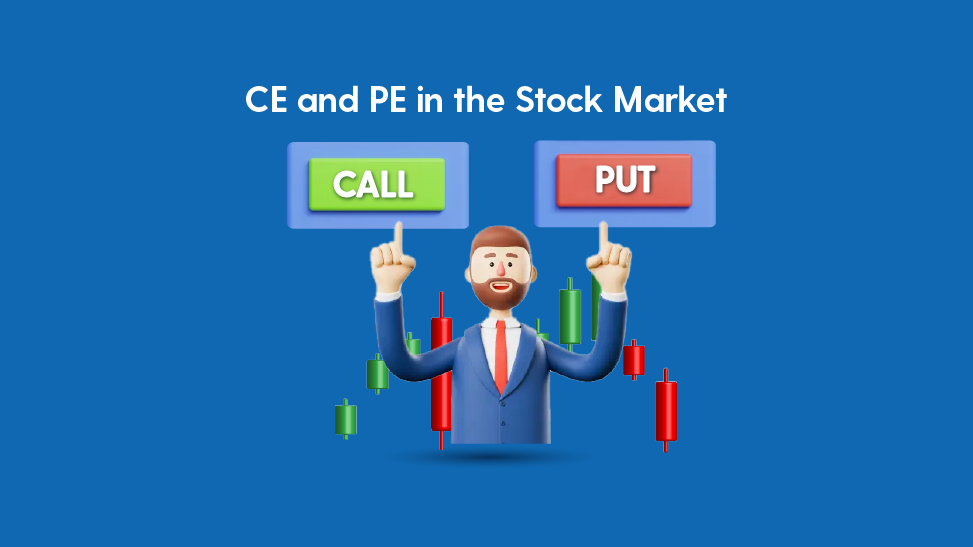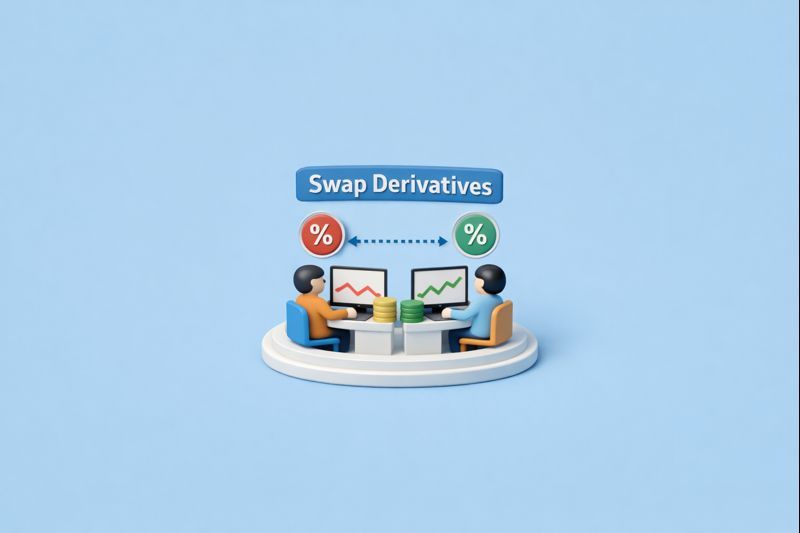What is CE and PE in the Stock Market?

- Published Date: September 18, 2024
- Updated Date: November 28, 2025
- By Team Choice
When you step into the world of derivatives trading, terms like CE and PE often come up. For new traders, options contracts can seem complex, but understanding them is key to exploring this type of trading. At their core, CE and PE are the two fundamental sides of an options contract, giving traders the flexibility to bet on both rising and falling markets.
In this blog, we’ll break down what CE and PE mean in the stock market and the broader future and option segment, how they differ, how they work in practice, their risks and rewards, along with examples, trading strategies, and common mistakes you should avoid.
Understanding CE and PE in the Stock Market
Call and Put options are financial contracts that let you buy or sell an asset at a pre-decided price. They help investors manage risk effectively and even create opportunities to benefit from market fluctuations. Let’s dive deeper into how they work.
What is a Call Option?
A Call Option (CE) is a type of options contract that gives the buyer the right, but not the obligation, to purchase an underlying asset (such as a stock or index) at a fixed price, known as the strike price, within a specific time frame.
The CE full form in the stock market is a Call European option, but traders commonly refer to it as a Put Option. Investors usually buy a Call Option when they expect the price of the stock or index to rise in the future.
Since the buyer only pays a small premium to enter the contract, the potential loss is limited to that premium, while the profit can be significant if the price moves upward.
What is a Put Option?
A Put Option (PE) is a type of options contract that gives the buyer the right, but not the obligation, to sell an underlying asset (such as a stock or index) at a fixed price, called the strike price, within a specified period.
The PE full form in the stock market refers to a Put European option, but it is commonly simply referred to as a Put Option. Traders generally buy a Put Option when they expect the price of a stock or index to fall.
CE vs PE: Key Differences
While both Call (CE) and Put (PE) options are types of derivative contracts, they work in opposite ways. Let’s understand the difference between PE and CE:
| Factors | CE (Call European) | PE (Put European) |
|---|---|---|
| Definition | Right to buy at a predetermined price | Right to sell at a predetermined price |
| Market Sentiment | Bullish (expecting price to increase) | Bearish (expecting price to decrease) |
| When to Use | Bought when anticipating a price rise | Bought when anticipating a price drop |
| Profit Opportunity | Profits when the asset’s price rises above the strike price | Profits when the asset’s price falls below the strike price |
| Risk Involved | High-level risk | High-level risk |
| Potential Gain | Unlimited profits as the price rises | Profits are capped by the difference between the strike price and the asset’s market price |
| Obligation to Execute | No obligation to buy, can let the option expire | No obligation to sell, can let the option expire |
| Expiration Period | Expiration set on a predetermined date | Expiration set on a predetermined date |
How CE and PE Options Work?
When you buy a CE or PE option, you’re not obligated to exercise it - you only have the right to do so. This flexibility is what makes options different from futures contracts.
How a Call Option (CE) Works:
- You pay a premium to buy the Call Option.
- If the market price goes above the strike price, your CE gains value.
- You can either exercise the option (buy at the strike price) or sell the option contract at a profit.
- If the market doesn’t rise, your loss is limited to the premium paid.
How a Put Option (PE) Works:
- You pay a premium to buy the Put Option.
- If the market price goes below the strike price, your PE gains value.
- You can exercise the option (sell at strike price) or sell the contract at a profit.
- If the market doesn’t fall, your loss is only the premium.
Practical Examples of CE and PE Trading
Understanding CE and PE in options becomes easier with real-world examples. These scenarios show how traders use them to profit from market movements.
Example of a Call Option (CE) Trade
Suppose Infosys is trading at ₹1,500. You believe the stock price will rise in the next month. You buy a CE with a strike price of ₹1,520 at a premium of ₹25.
- If the stock rises to ₹1,580 before expiry:
Profit = (1,580 – 1,520 – 25) = ₹35 per share.
- If the stock stays below ₹1,520:
You don’t exercise the option, and your loss is only the premium (₹25 per share).
Example of a Put Option (PE) Trade
Suppose Nifty is trading at 20,000. You expect the index to fall in the coming weeks. You buy a PE with a strike price of 19,800 at a premium of 50 points.
- If Nifty falls to 19,500 before expiry:
Profit = (19,800 – 19,500 – 50) = 250 points.
Since Nifty’s lot size = 50, total profit = 250 × 50 = ₹12,500.
- If Nifty stays above 19,800:
You don’t exercise the option, and your loss is limited to the premium = 50 × 50 = ₹2,500.
Trading Strategies for CE and PE Options
There are multiple ways traders can use Call (CE) and Put (PE) options to maximise returns or protect their portfolios. Here are some popular strategies:
1. Covered Call Strategy:
In this approach, an investor holds shares of a stock and sells a call option on the same quantity of shares. The premium received from selling the call generates extra income. This strategy works best when the investor expects the stock price to stay relatively stable or rise only slightly.
2. Protective Put Strategy:
This technique involves buying a stock and simultaneously purchasing a put option for the same stock. The put option acts as insurance; if the stock price falls, the investor can still sell at the strike price, limiting losses. At the same time, if the stock price rises, the investor benefits from the upward move.
3. Straddle Strategy:
A straddle is created by buying both a call option and a put option with the same strike price and expiry date. It is a market-neutral strategy, useful when an investor expects a big price movement but is uncertain whether it will be upward or downward. Profit potential exists in either direction, provided the move is large enough to cover the premiums.
4. Bull Call Spread Strategy:
In this method, a trader buys a call option at a lower strike price and simultaneously sells another call option at a higher strike price, both with the same expiry. This strategy reduces the cost of entry (since selling the higher strike call brings in some premium) and is useful when expecting a moderate rise in the stock price. The upside is capped, but the risk is also controlled.
Risks and Rewards of CE and PE Options
Trading Call (CE) and Put (PE) options can be attractive because they offer flexibility and leverage. However, like any investment tool, they come with both potential rewards and risks. Understanding these is crucial before trading:
Rewards of CE and PE Options
1. Limited Risk with Defined Cost:
When you buy a CE or PE, your maximum loss is limited to the premium paid. Unlike futures or direct stock trading, you’re not exposed to unlimited losses.
2. Potential for High Returns:
Options give you the ability to earn substantial profits if your market view plays out. A small movement in the underlying asset can translate into large percentage gains compared to the premium invested.
3. Flexibility to Profit in Any Market Direction:
- CE (Call Option): Helps you gain from rising prices.
- PE (Put Option): Let's you profit from falling prices.
This dual advantage makes options useful in both bullish and bearish scenarios.
4. Hedging Benefits:
Put options, in particular, work like an insurance policy. Investors holding stocks can buy PEs to safeguard against a sudden market downturn, ensuring peace of mind.
5. Leverage Advantage:
Options require a smaller initial outlay compared to buying stocks directly. With a lower investment, you can take exposure to the same asset and amplify potential returns.
Risks of CE and PE Options
1. Time Decay (Theta):
Options lose value as the expiry date approaches. Even if the stock moves in the right direction, a delayed move may reduce or wipe out potential profits.
2. Wrong Market Prediction:
If your market outlook is incorrect, for example, buying a CE when the price actually falls, or buying a PE when the price rises, you lose the entire premium paid.
3. Limited Lifespan:
Unlike stocks, which you can hold indefinitely, options have fixed expiry dates. If the expected move doesn’t occur within the given time, the option expires worthless.
4. Overuse of Leverage:
Options allow exposure to large positions with small capital. While this leverage can boost profits, it can also magnify losses if multiple trades go wrong.
5. Liquidity Concerns:
Some stock options may have low trading volumes, making it difficult to exit positions at the desired price, which increases the risk of slippage.
Common Mistakes to Avoid
Trading Call (CE) and Put (PE) options can be profitable, but many beginners make avoidable errors that lead to losses. Here are some common mistakes and how you can avoid them:
1. Trading Without Proper Knowledge: Jumping into CE and PE trading without understanding how strike prices, premiums, or expiry work often leads to quick losses. Learn the basics of options before investing real money.
2. Ignoring Time Decay: Many traders hold options until the last moment, not realising that options lose value as expiry approaches. Be mindful of time decay (theta) and exit early if the trade isn’t moving in your favour.
3. Over-Leveraging: Because options are cheaper than stocks, traders often buy too many contracts, hoping for big profits. This can magnify losses if the market goes the wrong way. Use proper position sizing and risk management.
4. Following Tips Blindly: Relying only on market tips or social media advice without personal analysis is risky. Always verify information and make decisions based on your own research.
5. Ignoring Market Volatility: Buying options during highly volatile periods can lead to inflated premiums. If volatility drops, even correct predictions may not yield profits. Check implied volatility before entering a trade.
6. Lack of a Trading Plan: Entering trades without defining an entry, exit, and stop-loss often results in emotional decision-making. Always have a clear strategy before placing an order.
Final Thoughts
Understanding what CE and PE in the share market is essential for anyone interested in options trading. A Call Option (CE) allows you to benefit from rising prices, while a Put Option (PE) helps you gain when prices fall. Together, they give traders flexibility to profit in both bullish and bearish markets, as well as provide tools for hedging against risk.
While CE and PE options can offer high rewards with limited losses, they are not risk-free. Factors like time decay, volatility, and incorrect predictions can lead to losing your premium. That’s why it’s important to approach options with the right knowledge, strategies, and discipline.
FAQs
1. Are CE and PE suitable for long-term investing?
Not really. CE and PE are designed for short-term trading and hedging. For long-term wealth creation, stocks and mutual funds are better options.
2. What are the main risks with CE and PE?
The main risks are time decay, wrong market predictions, and overexposure. However, unlike futures, your losses as a buyer are capped at the premium paid.
Recommended for you

Swap Derivatives: Meaning, Types, Benefits And Risks

Currency Derivatives

FII DII Data - Live Data
